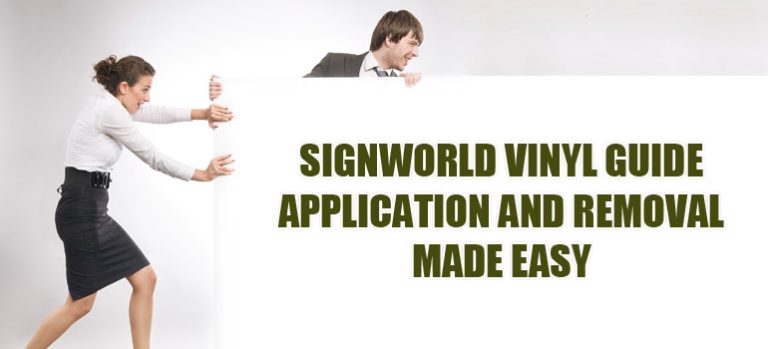In today’s post, the Signworld team shares some simple, step-by-step walkthroughs for vinyl sign application and removal.
Vinyl Installation 101
- Before you begin your application, make the the surface temperature is warm enough.
- Treat every surface as though it were already dirty. The first step in any vinyl installation should be cleaning. Household cleaners are acceptable, but a 2-to-1 mix of water and isopropyl alcohol is ideal. Wipe clean and dry after the wash is complete.
- Using a water-soluble pencil, measure and mark the area you’ve designated for your installation.
- Tape the right upper corner of your decal to the corresponding area on the substrate. Next, tape the left corner in place, making sure the logo is level. Finally, place a piece of tape down the center of the decal.
- Next, mark the right and left side of the decal with your pencil. Make sure they’re visible, as you’ll be aligning these marks later.
- Take the left side of the decal, hold the paper with your offhand, and peel the tape off until you reach the center of the decal.
- Cut the paper away, moving as close to the center as you can, and making sure not to scratch the surface.
- Spray the left side of the surface with water or application fluid if possible (unless you are using reflective vinyl).
- Lift up the right side of the decal and remove the backing paper. You may lift the center tape at this time.
- Apply application fluid to the right surface, then place the right side, making sure to align your pencil marks. Start at the center and squeegee out to the right. Make sure there are no wrinkles.
- Wait a few minutes before removing the application tape to give everything a chance to dry.
Vinyl Removal 101
Typically, it is possible to remove the vinyl lettering without causing any damage to the underlying surface material. That said, some substrate materials do react in unpredictable ways. For this reason, it’s always a good idea to run a few tests on less visible areas of the substrate to ensure you’re not exposing your car, building, or other property to risk. But don’t let that scare you; most surfaces respond very well to the vinyl removal techniques used by the Signworld team:
- First, heat the surface of the decal using a heat gun.
- Using a plastic squeegee, scrape the heated vinyl away from the surface. If the vinyl is relatively new, it may come off in fairly large chunks, whereas older vinyl usually comes off in small pieces.
- Once the vinyl has been peeled away, you will need to clean away the residual adhesive. Find a quality commercial adhesive remover that will not damage the underlying paint.
- Use soap and water to clean the surface to remove any final pieces of vinyl or adhesive.
If you’re trying to remove a decal that has been installed for a significant length of time, there is a chance that the paint around the vinyl shape may appear faded. This is particularly true if the decal is installed outdoors in an area that is exposed to a lot of natural sunlight. The end result is a kind of “tanline” effect where the surrounding area’s fading stands out in contrast to the darker, shinier area that was previously covered from the sun’s rays. This really cannot be avoided unless weather-resistant treatments are applied well in advance.
If your vinyl was installed on an old wooden sign, there is a good chance that the vinyl removal process will peel away some of the underlying color or coating.
Learn more about vinyl signage or consult directly with our experts at http://www.signworld.org




